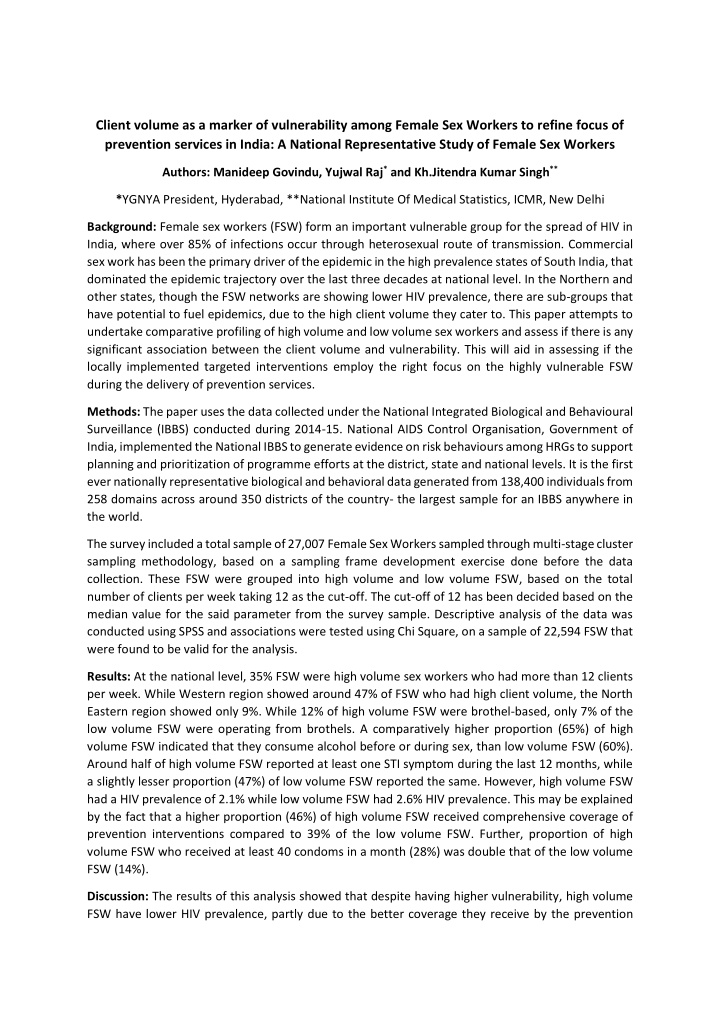



Client volume as a marker of vulnerability among Female Sex Workers to refine focus of prevention services in India: A National Representative Study of Female Sex Workers Authors: Manideep Govindu, Yujwal Raj * and Kh.Jitendra Kumar Singh ** * YGNYA President, Hyderabad, **National Institute Of Medical Statistics, ICMR, New Delhi Background: Female sex workers (FSW) form an important vulnerable group for the spread of HIV in India, where over 85% of infections occur through heterosexual route of transmission. Commercial sex work has been the primary driver of the epidemic in the high prevalence states of South India, that dominated the epidemic trajectory over the last three decades at national level. In the Northern and other states, though the FSW networks are showing lower HIV prevalence, there are sub-groups that have potential to fuel epidemics, due to the high client volume they cater to. This paper attempts to undertake comparative profiling of high volume and low volume sex workers and assess if there is any significant association between the client volume and vulnerability. This will aid in assessing if the locally implemented targeted interventions employ the right focus on the highly vulnerable FSW during the delivery of prevention services. Methods: The paper uses the data collected under the National Integrated Biological and Behavioural Surveillance (IBBS) conducted during 2014-15. National AIDS Control Organisation, Government of India, implemented the National IBBS to generate evidence on risk behaviours among HRGs to support planning and prioritization of programme efforts at the district, state and national levels. It is the first ever nationally representative biological and behavioral data generated from 138,400 individuals from 258 domains across around 350 districts of the country- the largest sample for an IBBS anywhere in the world. The survey included a total sample of 27,007 Female Sex Workers sampled through multi-stage cluster sampling methodology, based on a sampling frame development exercise done before the data collection. These FSW were grouped into high volume and low volume FSW, based on the total number of clients per week taking 12 as the cut-off. The cut-off of 12 has been decided based on the median value for the said parameter from the survey sample. Descriptive analysis of the data was conducted using SPSS and associations were tested using Chi Square, on a sample of 22,594 FSW that were found to be valid for the analysis. Results: At the national level, 35% FSW were high volume sex workers who had more than 12 clients per week. While Western region showed around 47% of FSW who had high client volume, the North Eastern region showed only 9%. While 12% of high volume FSW were brothel-based, only 7% of the low volume FSW were operating from brothels. A comparatively higher proportion (65%) of high volume FSW indicated that they consume alcohol before or during sex, than low volume FSW (60%). Around half of high volume FSW reported at least one STI symptom during the last 12 months, while a slightly lesser proportion (47%) of low volume FSW reported the same. However, high volume FSW had a HIV prevalence of 2.1% while low volume FSW had 2.6% HIV prevalence. This may be explained by the fact that a higher proportion (46%) of high volume FSW received comprehensive coverage of prevention interventions compared to 39% of the low volume FSW. Further, proportion of high volume FSW who received at least 40 condoms in a month (28%) was double that of the low volume FSW (14%). Discussion: The results of this analysis showed that despite having higher vulnerability, high volume FSW have lower HIV prevalence, partly due to the better coverage they receive by the prevention
interventions in the field. This also shows that the targeted interventions providing prevention services to the Female Sex Workers have been focussing the right sub-groups among FSW, thereby were able to contain the HIV prevalence among them. However, this picture at the national level might be different from that at state level with varying programme intensity of implementing FSW programmes. Also, the difference in epidemic potential based on client volume needs to be further analysed by maturity of FSW programme, presence of other factors such as collectivisation and community mobilisation among FSW, quality of FSW interventions, etc. in different states. Further analysis is also required to conclude more decisively the factors leading to low HIV prevalence among high volume FSW in India. Table : Bivariate analysis of Background & Behavioural Characteristics among Female Sex Workers : A National Representative Study of Female Sex Workers Low Volume Sex Chi- Background & Weighted High Volume Workers square Behavioural Samples(N) Sex Workers 14764 (65.30%) (P-value) Characteristics 22594 (100%) 7829 (34.70%) Region 22594 (100%) 7829 (100%) 14764 (100%) 566.35 North 2033 3617 5650 (.000) 25.00% 26.00% 24.50% Central 3167 1027 2140 14.00% 32.40% 67.60% East 3026 1200 1826 13.40% 15.30% 12.40% Northeast 1405 133 1272 6.20% 1.70% 8.60% West 1813 857 956 8.00% 10.90% 6.50% South 7533 2580 4953 33.30% 33.00% 33.50% Place of solicitation 153.21 Brother 1984 938 1046 (.000) 8.80% 12.00% 7.10% Others 20588 6883 13705 91.20% 88.00% 92.90% Self-Reported STI prevalence (At least one symptom) 21.45 Yes 10841 3922 6919 (.000) 48.00% 50.10% 46.90% No 11753 3907 7846 52.00% 49.90% 53.10% Comprehensive Coverage 8500 3241 5259 36.85 Yes (.000) 41.10% 46.09% 38.84% 12070 3790 8280 No 58.67% 53.90% 61.15% Received at least 40 Condoms 576.72 Yes 3894 1971 1923 (.000) 18.90% 28.00% 14.20% No 16676 5060 11616 81.10% 72.00% 85.80% HIV Test Result 5.56 Negative 22052 7667 14385 (.000) 97.60% 97.90% 97.40% Positive 542 162 380 2.40% 2.10% 2.60%
Recommend
More recommend